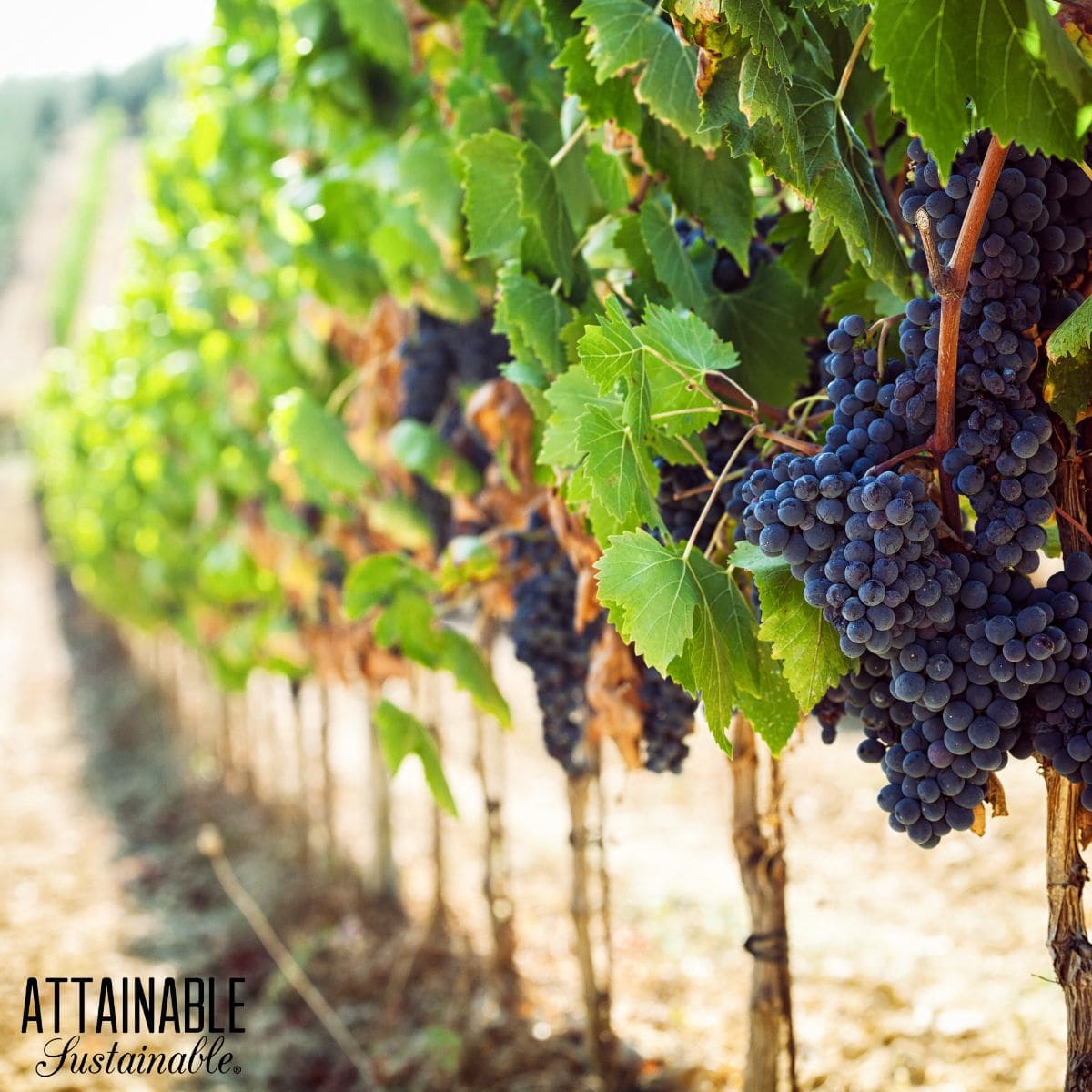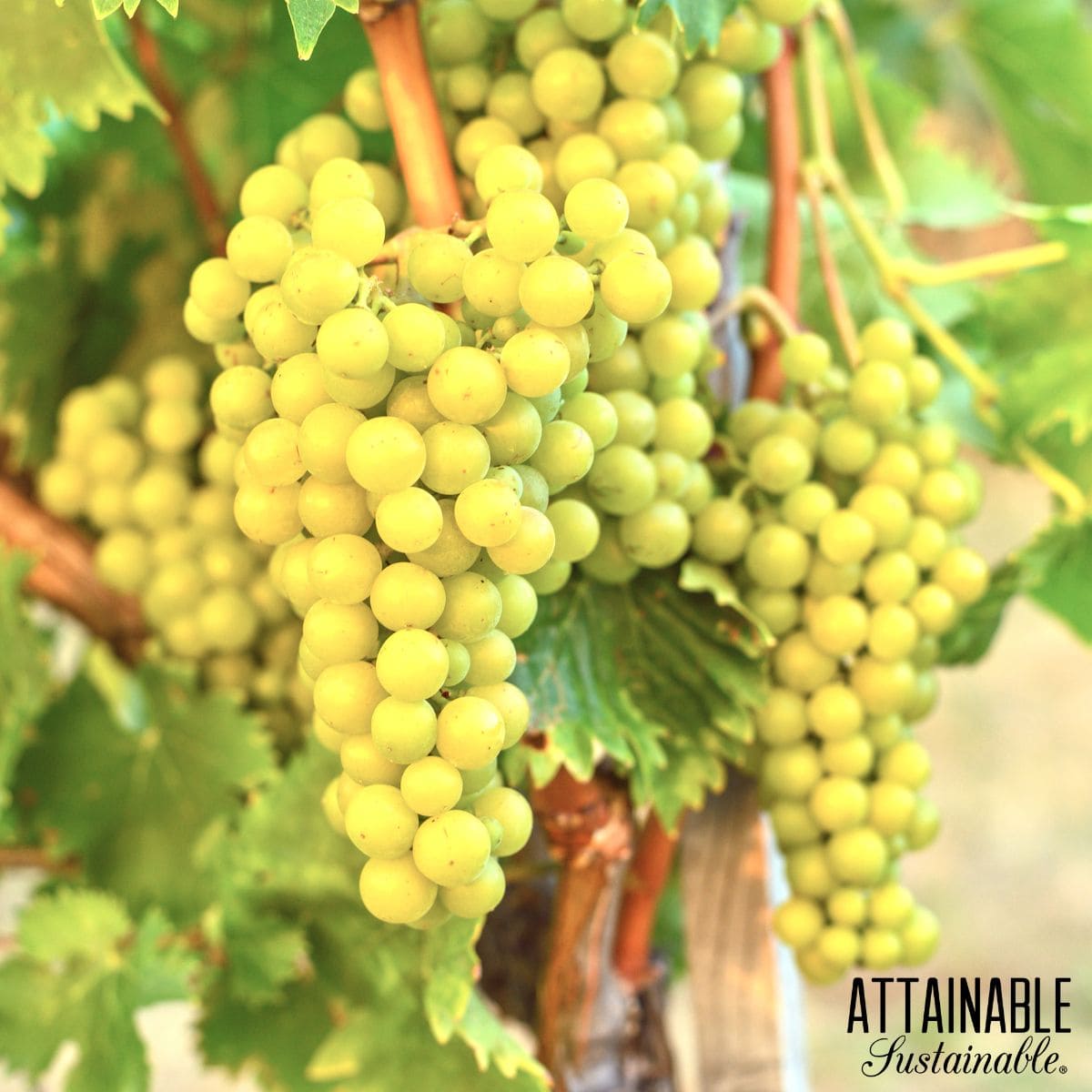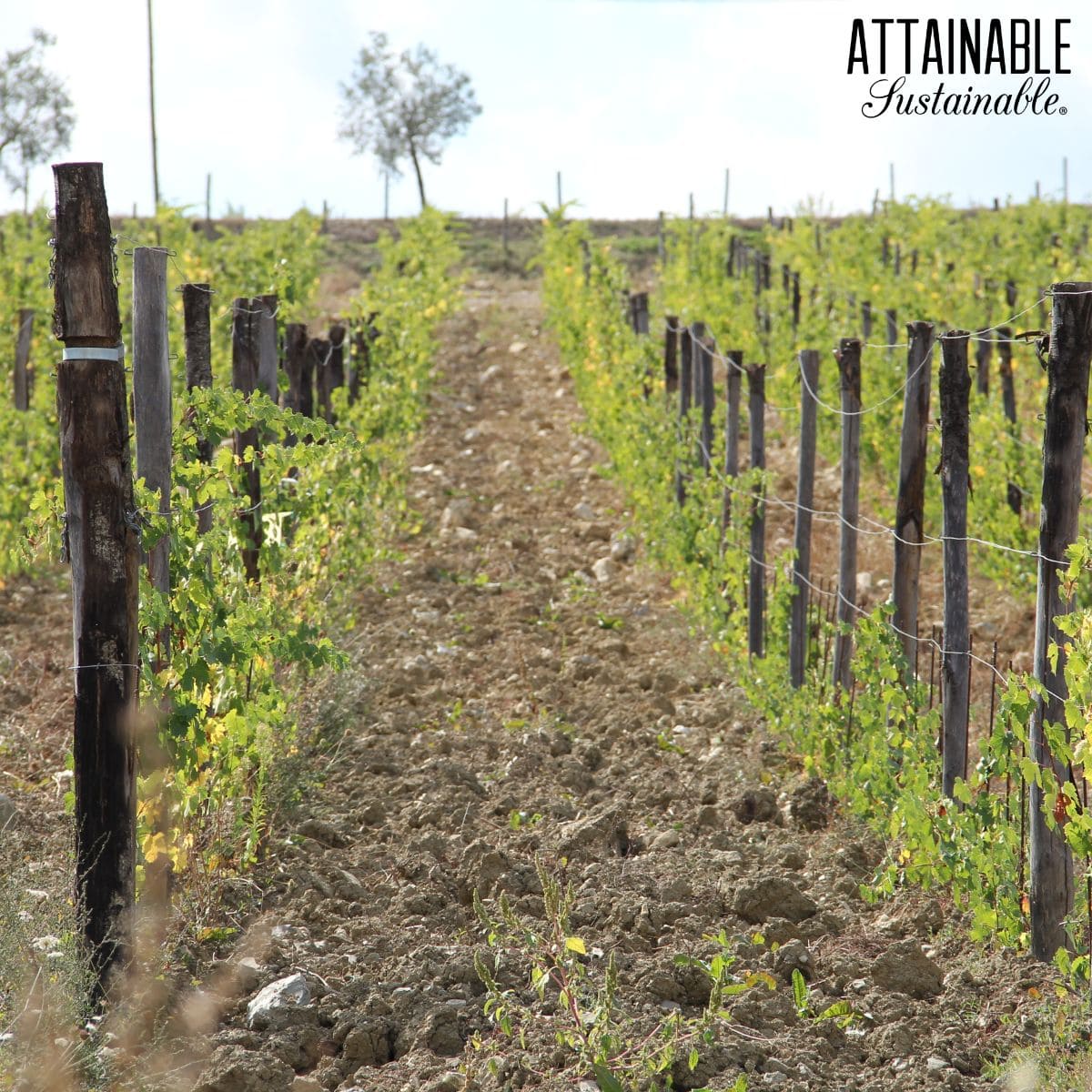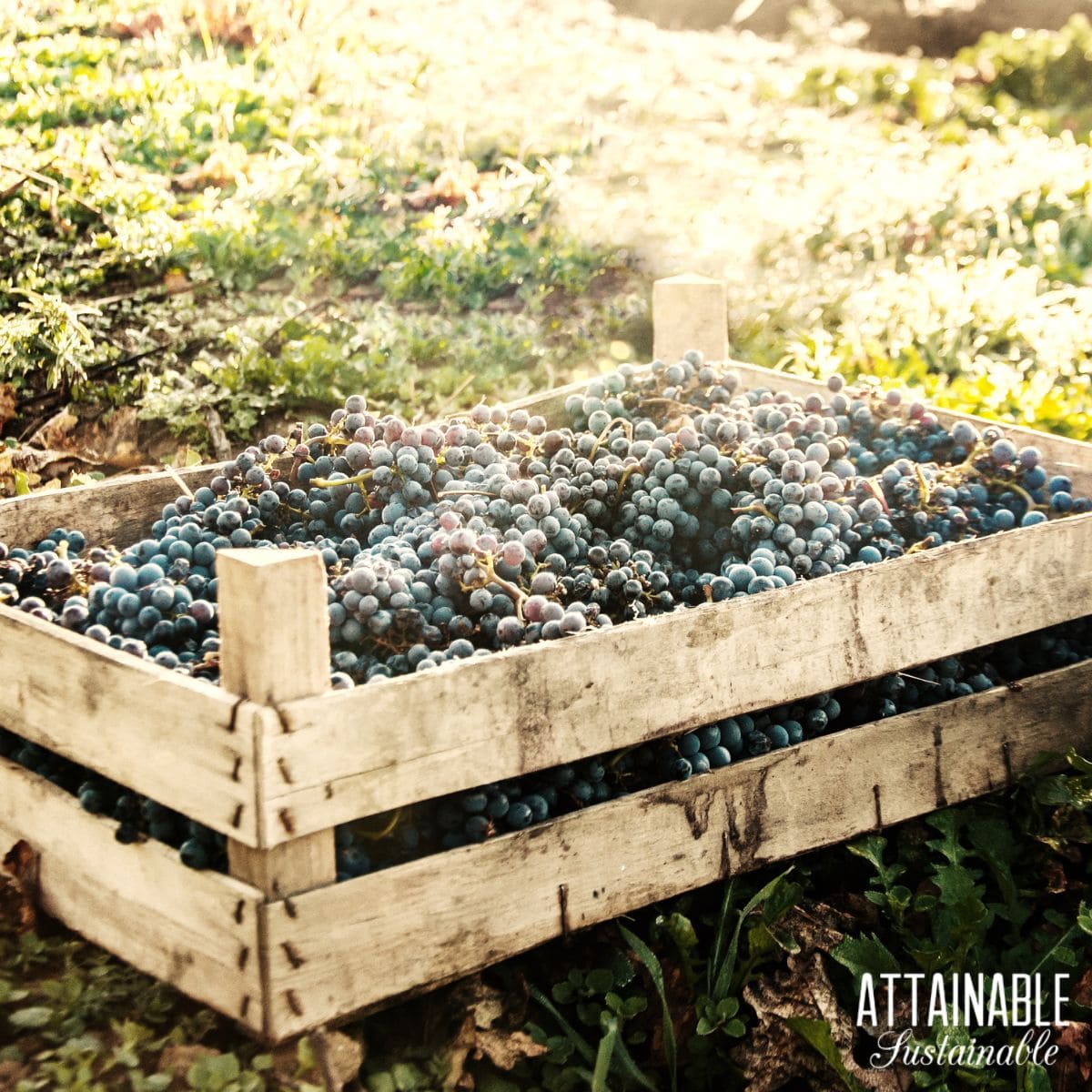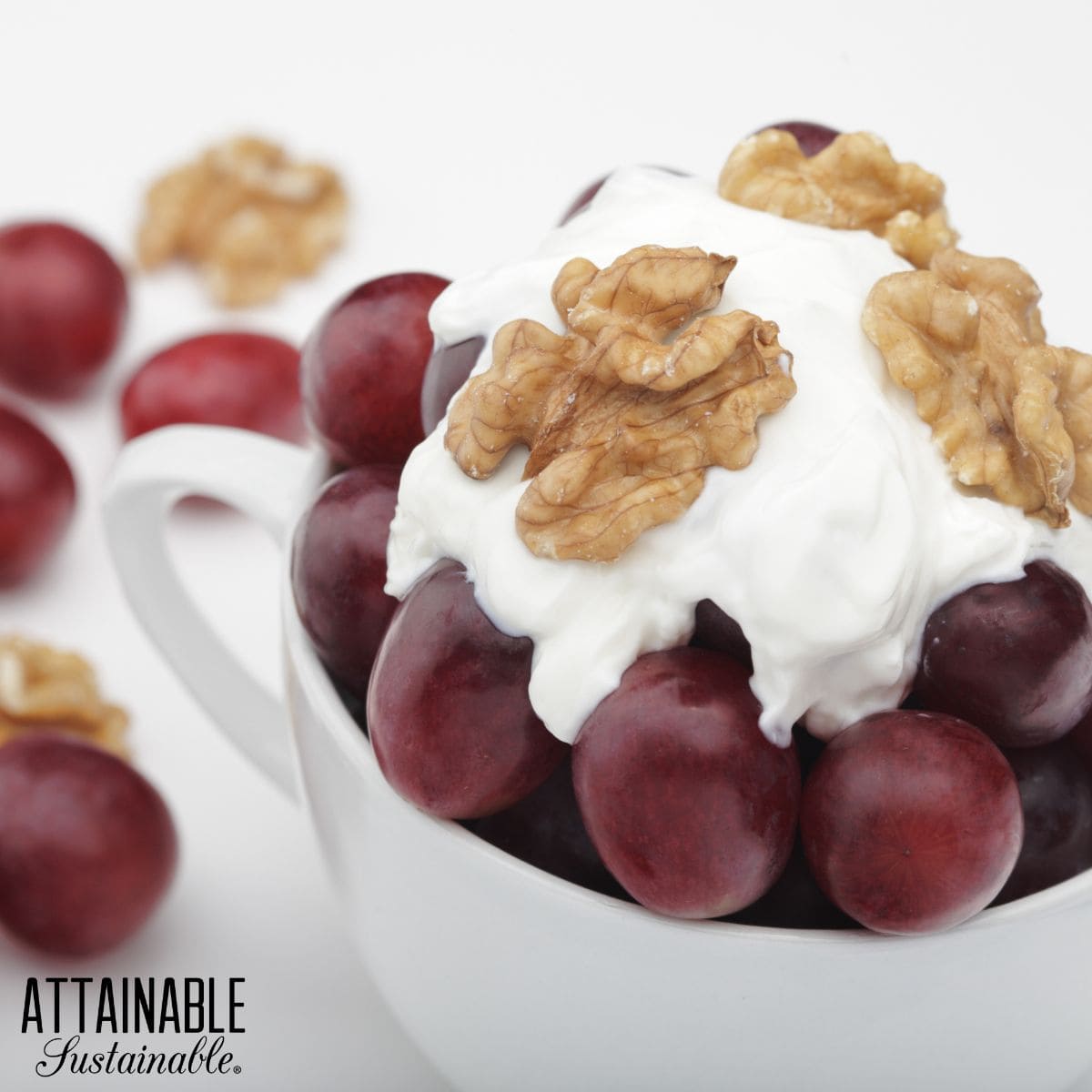Growing grapes is a fruitful way to use some of your garden space. Although it may take some time before you get fruit, once you do you’ll be delighted by the flavor and versatility of homegrown grapes. They are beautiful plants, and the leaves are edible too!
Another delicious and beautiful fruit to grow is gooseberries!
Contributed by Jodi Torpey, author and Master Gardener.
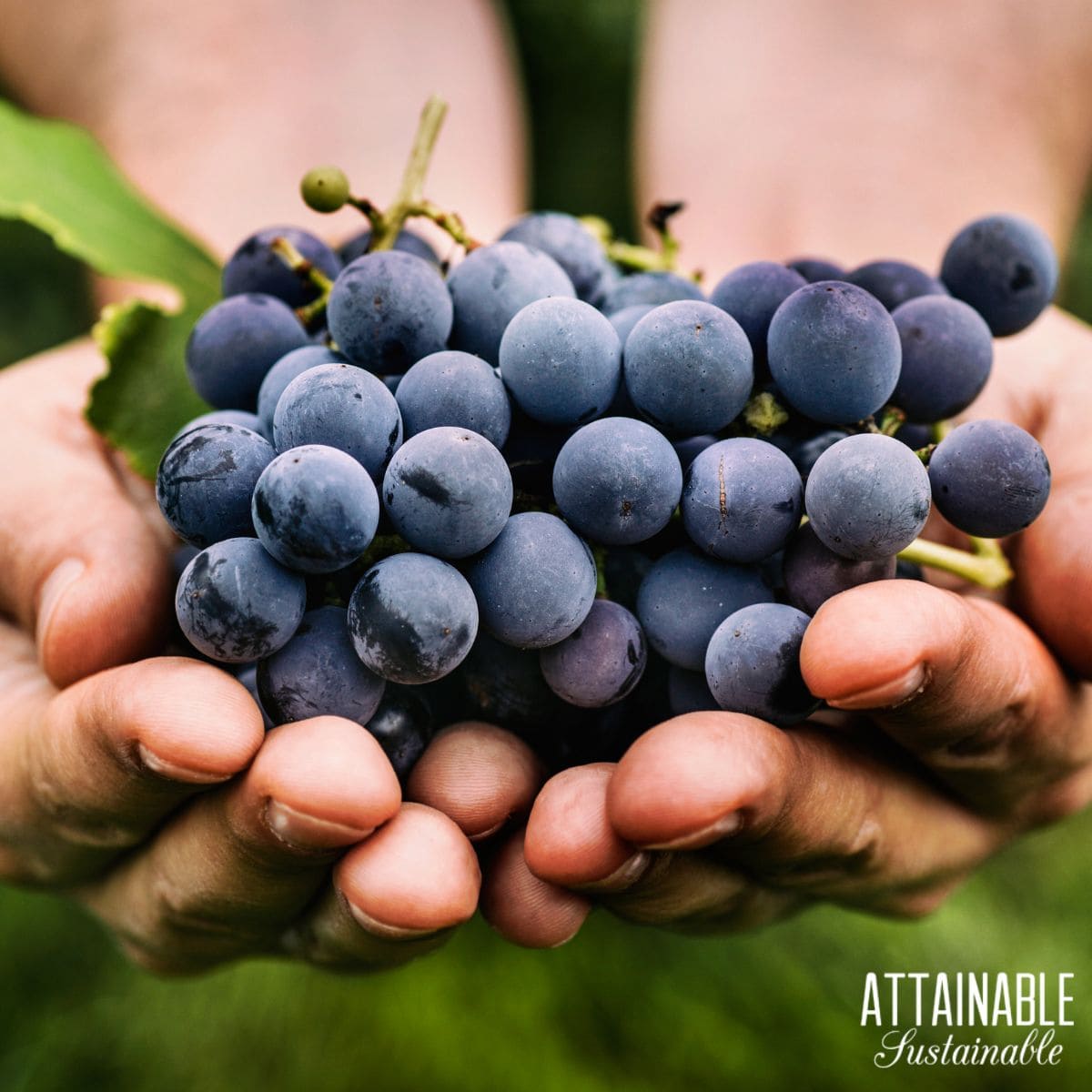
Is there a gardener who wouldn’t want to grow grapes? These luscious clusters of colorful fruits grow on woody, perennial vines in temperate climates around the globe. Grapes (Vitis vinifera) are berries that can be eaten fresh off the vine or made into juice jam, jelly, and wine. The perennial vines are gorgeous in summer when covered with beautiful green leaves or in winter when the vines are bare.
It takes planning and patience to plant and grow grapes. First, you’ll need to carefully consider the planting site, because vines have the potential to grow in that location for many years. Second, you’ll need to select the variety of grapes that are known to grow well in your region. Also, keep in mind it may take four or more years for vines to reach full production.
New to gardening? Limited on space? The 5-Gallon Garden gives you the skills you need to grow food in the space you have. Get started with your garden today!
Grow Some Greens!
Ready to grow fresh greens, no matter WHERE you live? Sign up for my
FREE quick-start guide and start growing some of your own food!
Best Sites for Growing Grapes
Select a sunny site for planting, preferably a warm, sloping area that’s well-protected from damaging winds. In cold-weather climates, look for a south-facing slope or the south side of the house and avoid planting in a low area that will attract cooler air.
No matter your region, you’ll need a site with a good source of water, but avoid planting grapes in lawn areas. Grape vines have different needs when it comes to water, fertilizer, and especially lawn chemicals, if you use them. It’s important to give vines their own space well away from trees and other landscape plantings. Vines won’t do as well when having to compete for sun, water, and nutrients.
Grape Varieties for Home Gardens
When selecting the grape varieties to grow, be sure to read plant descriptions carefully and match the type of grapes to the environmental conditions of your region. In cold-weather climates, hardy grape varieties for your area’s hardiness zone are the better choice. For example, in some areas where springtime temperatures drop below zero for several days in a row, grape canes can die and take several years to recover.
Select the grapes based on your area’s number of frost-free days to make sure there will be enough time to grow and ripen.
Here is a sample of popular grape varieties for juice, jelly, and wine:
Somerset Seedless is a red seedless grape that’s bred for Zones 4-8. This table grape has a sweet flavor that deepens the longer the grapes are left on the vine. Good for eating fresh, and making juice and jelly.
Himrod Seedless is a golden amber grape that grows in Zones 5-8. These sweet grapes ripen earlier than some other grape varieties to enjoy sooner in the season.
Concord Seedless is like the old favorite Concord grape but without the seeds. These tasty juice and jelly grapes grow in Zones 4-8 and ripen in mid-September.
Frontenac is a hardy wine grape that grows in Zones 4-8. These grapes make high-quality red wine. Grapes ripen midseason.
Brianna is a white wine grape that grows in Zones 3-9. These grapes make a semi-sweet white wine, and a nice grape juice, too. Grapes typically ripen in August.
St. Croix is another sweet, red wine grape for Zones 4-8. Grape vines are known for being very productive with the grapes ripening in late August.
How to Grow Grapes
Grapes can be planted from bare root vines in early spring as soon as the soil can be worked or as potted vines after the last frost has passed for your area.
After you’ve selected the best site, arrange vines so they will be in rows that orient north and south. Dig a deep planting hole that’s large enough to spread the roots without bending them. Prune off broken roots.
Give vines room for air to circulate between plants and space plants 6-10 feet apart in rows, and rows 6-10 feet apart.
Keep in mind the goal of the first two growing seasons is to help grape vines develop a single trunk as well as a healthy root system. The flowers and fruit develop on new shoots that are called canes. Wind and insects help pollinate flowers that grow on the vine.
Add drip irrigation or a soaker hose to ensure grapes receive enough water on a consistent basis until the vines are well-established.
Grapes will need to be trained to grow on a strong trellis, arbor, fence, or other sturdy, long-lasting support. Consider treated wooden posts with strings of at least 12-gauge wire strung between them.
Requirements for Growing Grapes
Soil requirements
Grape plants prefer deep, well-drained soil that’s free of salts. When digging in compost or other organic matter, make sure the amendments don’t add salt to the soil.
Keep the grape-growing area weed-free by pulling weeds or carefully cultivating under vines. Don’t add mulch in warm weather, but wait until winter to protect roots from fluctuating temperatures and drying winds in winter. Remove mulch in spring.
Light requirements
Grapes need full sun so the plants can grow and fruit to ripen.
Fertilizer and water requirements
In spring fertilize with a 21-0-0 fertilizer when vines start growing on taking on buds. Keep in mind roots can spread several feet from the base of the vine, so broadcast the fertilizer over the entire area, not just next to the trunk. Water in.
Avoid overwatering grapes, especially in spring. However, keep up with regular irrigation throughout the season. In fall stop watering after harvesting or when leaves begin turning color.
Preventing Grape-Growing Problems
Many problems with growing grapes can be reduced with careful planning before planting. Make sure grapes are planted where they’ll get plenty of sun and space them for good air circulation. Weather, winter temperatures, and any problems from previous seasons can also affect grape production.
Another key to grape growing is making sure to prune the vines and prune them correctly. Grape vines need annual pruning to produce the best crops of grapes over the long term.
Pruning begins in the second year and helps ensure the vines receive enough sunlight for the grapes to ripen. Prune in spring before leaves emerge. Grape vines should be pruned so there is one clear trunk, and the other canes pruned to 2-3 buds. Prune off any unwanted shoots as plants are growing.
Prevent damage from squirrels and birds by protecting grapes with netting that has tight crosswires or cover individual clusters.
Harmful insects and plant diseases can also affect grape production. Japanese beetles and powdery mildew are two common issues.
Japanese beetles chew holes in grape leaves, leaving behind skeletons. Monitor plants throughout the season beginning in late June through August for these pests. The best control is to knock the beetles off of plants and into a bucket of soapy water.
Powdery mildew can affect all parts of grapevines. Prevent this plant disease with good air circulation between plants and remove any diseased portion at the first sign to keep it from spreading.
Of course, there are other potential plant problems, so check with your County Extension for problems specific to your region.
Growing Grapes in Containers
You might be surprised to learn grapes can grow in containers. A 15–20-gallon container will be large enough to support one grapevine.
Look for a dwarf variety of grapes that will do well in your hardiness zone and plant during the typical warm planting time for your region. Select a self-pollinating variety if you’re planning on growing just one plant.
Fill the container with a good-quality potting mix that has a slow-release fertilizer. Plant the grape plant, either bare root or potted, according to the plant’s specifications. Water deeply and regularly to help roots get off to a good start. Avoid overwatering to keep roots healthy.
Give the container space so that air can circulate around the planted container. Add a strong trellis and train the vine to grow vertically through the season.
In cold-weather regions, you’ll need to protect the container from freezing in winter. Move the container into an unheated garage or shed that doesn’t get below freezing. In warmer climates, you can protect your container outside by surrounding it with insulating materials or sinking the pot into the soil.
How to Harvest Grapes
Keep track of the anticipated harvest time based on the grape varieties you’re growing. Most grapes typically ripen from August through October but check your grapes and harvest based on their color, sweetness, and flavor. Use sharp bypass pruners to clip grape clusters from vines when they are at their peak; plump, full-flavored, and blemish-free.
Store unwashed grapes in a plastic bag in the refrigerator. Wash grapes before eating and use them within a week.
How to Use Grapes in the Kitchen
Table grapes are sweet and make a delicious addition to summer meals. Use them in sweet and savory salads or eat them fresh for dessert.
You can also turn grapes into jam, jelly, and other preserves or use your wine grapes for a special beverage. Canning whole grapes is another way to preserve them.
Grape leaves are also handy for Greek and Middle Eastern recipes.
Propagating grapes
The most common method for propagating grapevines is by taking cuttings. Collect one-year-old growth that has long, straight shoots.
Cut the shoots, dip the cut end in rooting hormone, and plant in potting soil. Keep the soil moist and the plants in a warm and humid environment. Rooting can take anywhere from 2-6 weeks.


